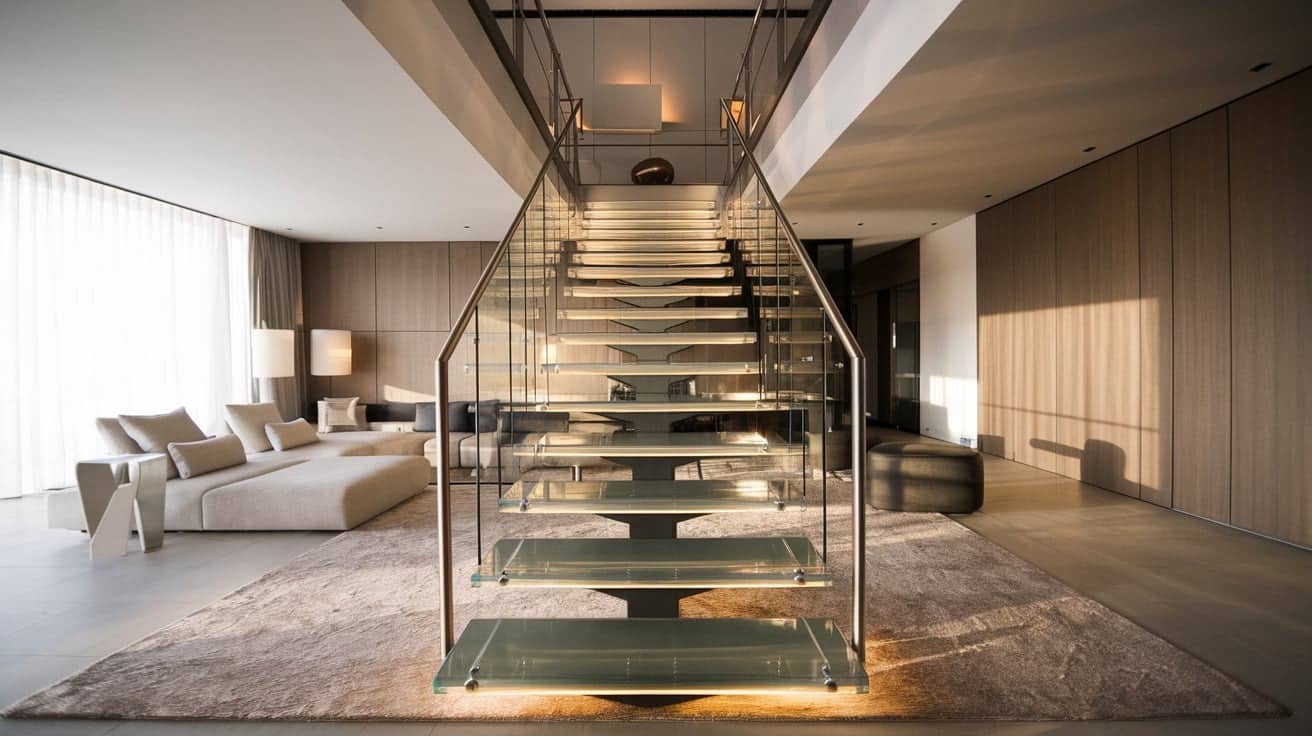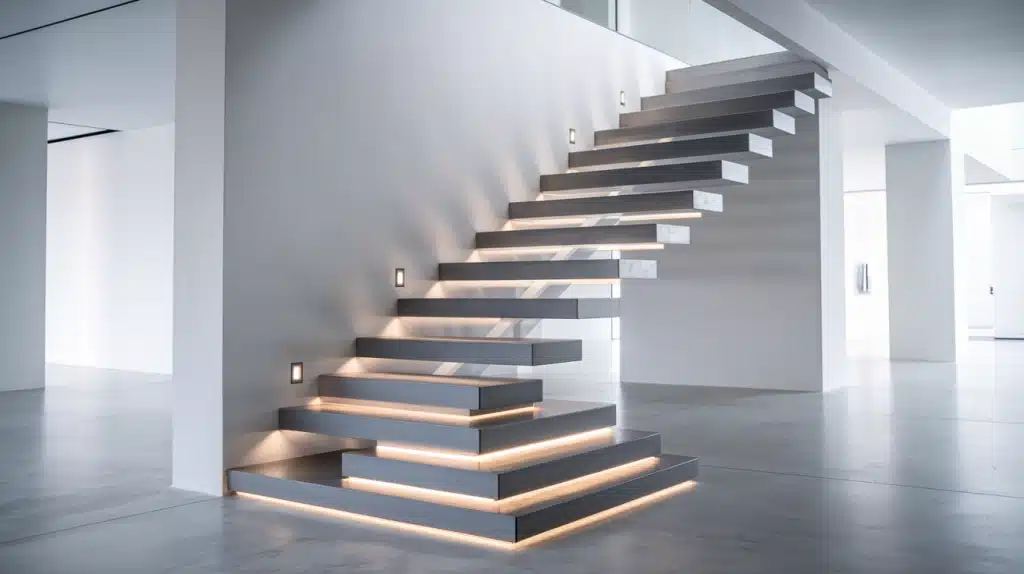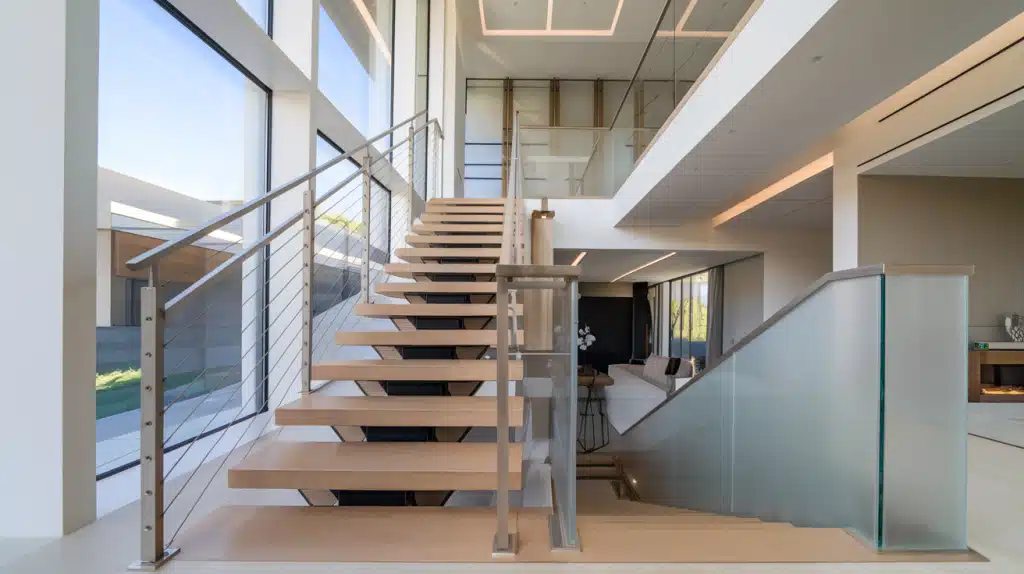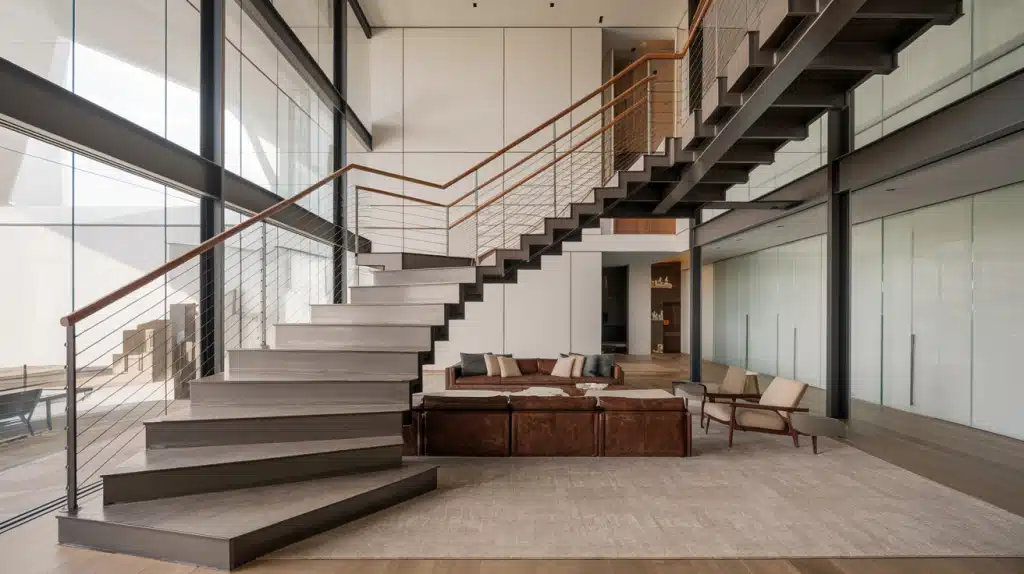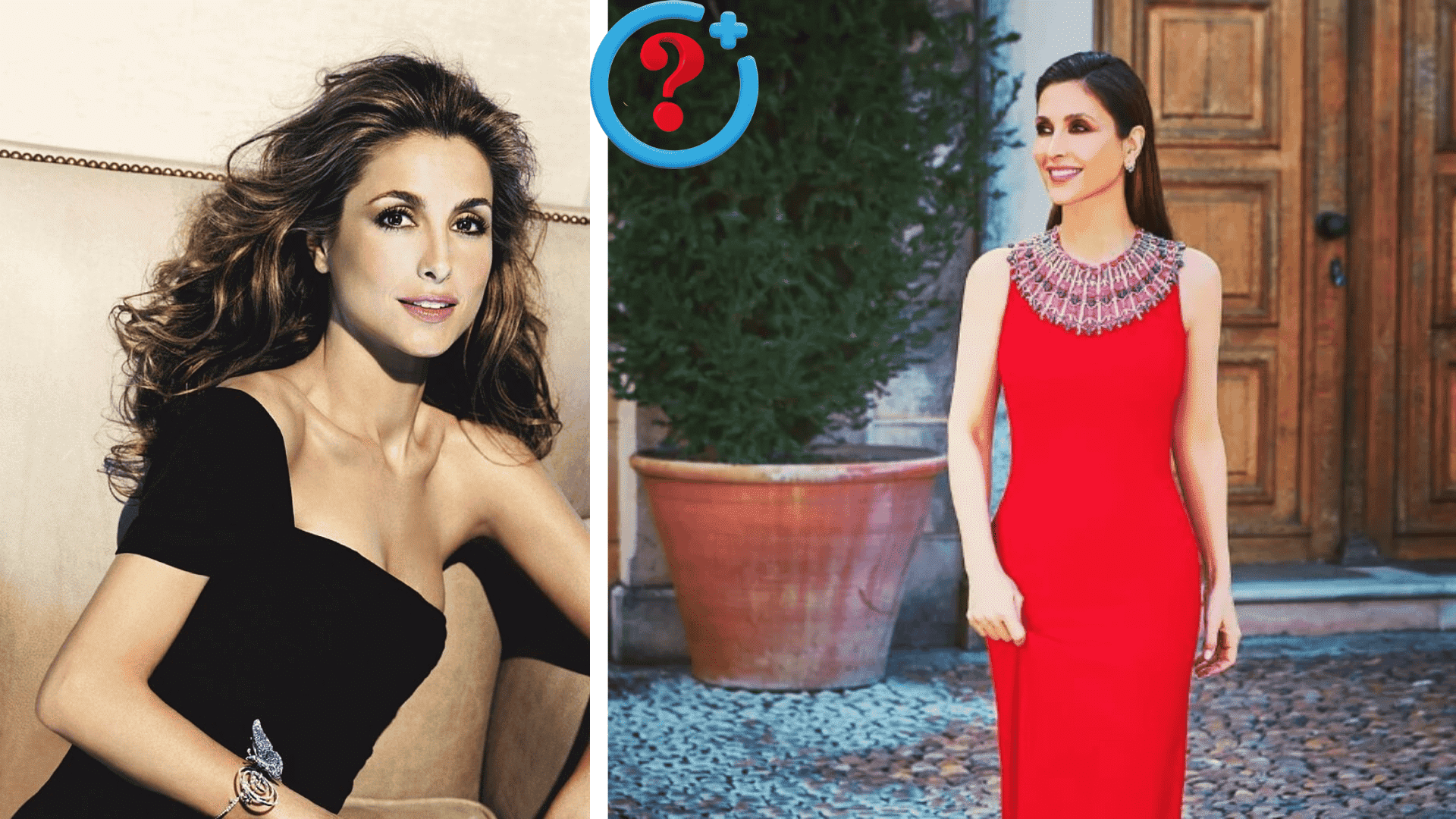Looking to update your home’s interior?
Many homeowners overlook one key feature that can completely change their living space – the staircase.
While traditional stairs simply connect floors, today’s staircases are central design elements that pull attention and start conversations.
Modern home design has moved beyond basic wooden steps and simple handrails.
Homeowners now choose stairs that blend style with purpose, creating striking visual elements that enhance their living areas.
This guide will show you how to select and plan a modern staircase that fits your space perfectly.
We’ll examine different materials, explore design options, and cover essential planning considerations to help you create a practical and visually appealing staircase.
Materials That Make A Statement In Contemporary Staircase
Choosing the right materials for your modern staircase can turn a simple passageway into a standout feature of your home.
Let’s look at the key materials that work well in current staircase designs:
1. Wood: A Time -Tested Choice
Wood remains a popular choice for modern staircases because it offers both warmth and flexibility in design.
From rich oak to light maple, wood can be finished in various ways to match your home’s style.
Its natural patterns and textures add character while maintaining a clean, modern look.
2. Metal: Strong and Striking
Metal components bring a modern touch to staircases. Steel and aluminum are often used in railings and structural supports.
These materials work particularly well in modern designs because they can be shaped into thin, strong elements that appear to float.
Black matte or brushed steel finishes offer a subtle yet impactful look.
3. Glass: Creating Space
Glass elements in staircases make spaces feel larger and more open.
When used in railings or treads, glass allows light to flow freely through your home.
Safety glass panels provide necessary protection while maintaining a light, fresh appearance.
4. Combined Materials: Creative Mixing
The most interesting modern staircases often mix different materials.
Think of wooden treads with glass railings or a metal framework supporting wooden steps.
These combinations create visual interest while letting each material’s strengths shine through.
Design Variations In Contemporary Staircases
Modern staircase designs offer various options that can transform your home’s interior. Here are the key styles that define current staircase trends:
1. Floating Steps
These steps appear straight out of the wall, creating a minimal look that catches attention.
Without visible supports, floating steps make your space feel more open and bright.
The design works especially well in smaller homes where traditional staircases might feel too heavy or take up too much room.
2. Modern Railing Systems
- Cable Systems: Thin steel cables run horizontally between posts, offering a clean look while meeting safety requirements. These systems work well in both small and large spaces.
- Glass Panels: Clear or frosted panels provide safety barriers while keeping sight lines open. They’re perfect for homeowners who want to maintain an open feel while ensuring family safety.
3. Creative Angles And Forms
Modern staircases break away from standard straight lines. Zigzag patterns, curved forms, and offset steps add visual interest.
These designs turn the staircase into an art piece that draws attention while serving its basic purpose.
Each design can be modified to fit your space and style preferences.
The key is selecting a variation that works with your home’s architecture and meets your daily needs.
Planning Your Contemporary Staircase
A) Space Considerations
1. Floor Plan Evaluation: Before selecting a staircase design, measure your available space carefully.
Consider both the ground floor footprint and the upper landing area.
The total space needed includes room for comfortable foot traffic and safety clearances.
2. Height Calculations: Measure the total rise (floor-to-floor height) accurately.
This measurement determines the number of steps needed and their individual heights.
Standard step heights typically range between 6.5 to 7.75 inches for comfort and safety.
3. Width Planning: Standard residential staircases require a minimum width of 36 inches, but modern designs often go wider for visual impact.
Consider how the width affects both traffic flow and the overall room proportions.
B) Material Selection
1. Long-Term Performance: Different materials require varying levels of upkeep:
-
- Wood needs regular finishing and may show wear patterns
- Metal components require checking for secure connections
- Glass panels need frequent cleaning to maintain clarity
- Combined materials might have different maintenance schedules
2. Daily Use Factors: Consider how materials perform under your specific conditions:
-
- High-traffic areas might need more resilient materials
- Homes with children might require more grip-friendly surfaces
C) Environmental Factors
1. Light Integration: Consider how your staircase design affects natural light flow:
-
- Open designs allow more light distribution
- Glass elements can help brighten darker areas
- Material finishes can reflect or absorb light
2. Temperature Effects: Think about how materials react to your environment:
-
- Wood might expand or contract with humidity changes
- Metal can feel cold in winter months
- The glass might create greenhouse effects in sunny spots
Budget Planning For Your Contemporary Staircase
1. Material Costs
- Evaluate material pricing: standard wood treads are $100-200, while specialized glass treads cost $500-1000. Include basic material costs and necessary finishes.
- Request samples of materials to examine quality differences between price points, helping you make informed decisions about where to invest more money.
2. Labor And Installation
- Installation usually makes up 40-60% of total project costs. Complex designs involving multiple materials or floating steps need specialized skills, raising labor costs.
- Factor in preparation work, including demolition of existing stairs, structural reinforcement, and any necessary modifications to surrounding walls or floors.
3. Additional Elements
- Include costs for safety features like handrails, balusters, and non-slip treatments. These essential components often add 15-25% to the base cost but are crucial for both safety and code compliance.
- Consider lighting integration costs – built-in LED strips or under-step lighting can add $500-1500 but significantly enhance both safety and visual appeal.
4. Long-Term Investment
- Allocate 10-15% of your budget for installation and maintenance. Different materials have various upkeep costs; glass needs frequent cleaning, while wood may require refinishing every few years.
- Consider the effect on your home’s resale value. Modern staircases can boost property value by 3-5%, making them a worthwhile investment when well-planned.
Conclusion
A well-planned modern staircase does more than connect your home’s levels – it adds significant value to your living space.
By selecting the right combination of materials, considering your space requirements, and following proper safety guidelines, you can create a functional and striking staircase.
Remember to take time to plan your design, as this investment will impact your home’s appearance and function for years to come.
Consider working with qualified professionals who understand building codes and can help bring your vision to life.
Ready to start your staircase project?
Begin by measuring your space and reviewing the material options we’ve discussed.
Frequently Asked Questions
How Do You Make Stairs Look Modern?
Modern stairs stand out with clean lines and simple designs.
Use glass panels instead of traditional railings, opt for floating steps, or combine materials like wood and metal for a current appearance.
What Is The Gentleman Rule On Stairs?
The gentleman’s rule on stairs traditionally states that a man should walk below or behind a woman when going up stairs and ahead of her when going down to ensure her safety and privacy.
What Is The 7-Eleven Rule For Stairs?
The 7-11 rule is a basic stair-building standard: each step’s riser (vertical height) should not exceed 7 inches, while the tread (horizontal depth) should be at least 11 inches for safe, comfortable walking.

